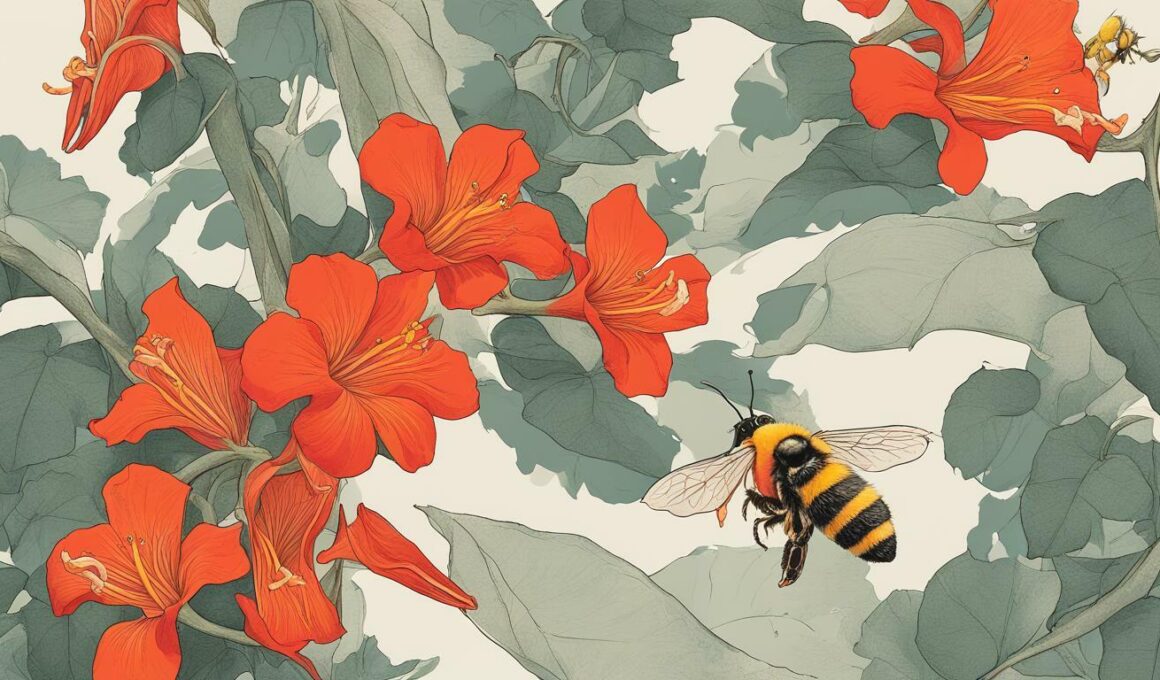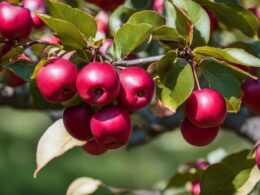If you have ever marveled at the sight of a trumpet vine flower, you may have wondered how they are so brilliantly adapted to attract pollinators. These flowers have evolved incredible adaptations that allow them to attract specific pollinators, such as hummingbirds and bees, ensuring successful pollination.
Post Summary:
- Trumpet vine flowers have unique adaptations that help attract their pollinators.
- These adaptations include vibrant colors, specific shapes, enticing scents, and delicious nectar.
- By understanding these adaptations, we can better appreciate the vital role these flowers play in our ecosystems.
The Characteristics of Trumpet Vine Flowers
Trumpet vine flowers have evolved specific characteristics to ensure they attract their pollinators. The flowers are known for their bright colors, unique shape, enticing scents, and delicious nectar. All of these attributes work together to create a unique and attractive flower that pollinators can’t resist.
The Vibrant Colors of Trumpet Vine Flowers
One of the most noticeable characteristics of trumpet vine flowers is their vibrant color. They are typically a bright orange or red hue, which is a significant visual cue for their pollinators. The intense color is believed to attract pollinators from a significant distance away and has evolved to ensure successful pollination.
The Unique Shape of Trumpet Vine Flowers
The unique shape of trumpet vine flowers is another defining characteristic that sets them apart from other flowers. The tubular shape of the flowers is perfect for certain pollinators, such as hummingbirds, that have long tongues. The shape of the flower also ensures that the pollinator comes in contact with the flower’s reproductive structures, increasing the chances of successful pollination.
The Enticing Scents of Trumpet Vine Flowers
Trumpet vine flowers also have a distinctive scent that helps to attract certain pollinators. The scent is potent and sweet, and it is believed to attract bees and hummingbirds, both of which have a keen sense of smell. The fragrance works in conjunction with the color and shape of the flower to create the perfect pollinator attractant.
The Delicious Nectar of Trumpet Vine Flowers
Finally, the delicious nectar produced by trumpet vine flowers is another essential characteristic that plays a vital role in attracting pollinators. The nectar is typically sweet and plentiful, making it an attractive food source for hummingbirds and bees. The nectar is also strategically located deep within the flower, ensuring that the pollinator comes in contact with the flower’s reproductive structures while feeding on the nectar.
Overall, the unique characteristics of trumpet vine flowers have evolved to attract specific pollinators effectively. The bright colors, unique shape, enticing scents, and delicious nectar of these flowers work together to create the perfect pollinator attractant. Understanding these characteristics can help us appreciate the vital role that trumpet vine flowers and their pollinators play in our ecosystems.
Pollination Strategies of Trumpet Vine Flowers
Trumpet vine flowers have evolved unique adaptations to ensure successful pollination. Their shape, color, and scent are specifically tailored to attract certain pollinators, and they also have mechanisms in place to transfer pollen efficiently.
Shape and Color
Trumpet vine flowers have a distinct funnel shape, which is ideal for attracting hummingbirds. The narrow opening of the flower allows the hummingbird to insert its long bill and tongue to reach the sweet nectar deep inside the flower. The bright red or orange color of the flower is also highly attractive to the hummingbird, as they are particularly drawn to these vibrant hues.
The shape of the flower also serves as a landing platform for bees, who are attracted to the trumpet vine flower’s yellow throat. The wider shape of the flower allows the bee to easily land and crawl around the inside of the plant to collect pollen.
Scent and Nectar Production
The trumpet vine flower’s scent is another powerful attractant for pollinators. The sweet aroma of the flower serves as a signal to bees and hummingbirds that nectar is available for consumption.
The flower’s nectar production is another important adaptation. The trumpet vine flower produces copious amounts of nectar, which is a high-energy food source for pollinators. This abundance of food helps encourage pollinators to return to the flower, ensuring successful pollination.
Efficient Pollination Mechanisms
Trumpet vine flowers have several mechanisms in place to transfer pollen efficiently. For example, the flower’s anthers are positioned in such a way that they are in contact with the pollinator’s body as it feeds on the nectar. This ensures that pollen will be transferred to the pollinator’s body and carried to the next flower, facilitating successful pollination.
Additionally, the trumpet vine flower’s stigma is sticky, allowing it to easily trap pollen grains as they come into contact with it. This efficient transfer of pollen allows for successful fertilization, ensuring the production of viable seeds.
Overall, the trumpet vine flower’s unique adaptations serve as a testament to the incredible evolutionary relationships between plants and their pollinators. By understanding and appreciating these adaptations, we can better appreciate the vital role that trumpet vine flowers and their pollinators play in our ecosystems.
Attracting Pollinators with Trumpet Vine Flowers
To attract their pollinators, trumpet vine flowers have evolved various strategies that involve their color, shape, scent, and nectar production. The bright red or orange color of the flowers act as a visual cue to pollinators, standing out against the green foliage. The trumpet-shaped flowers with flared petal edges provide landing platforms for pollinators like hummingbirds, while also making it easier for bees to access the nectar.
The fragrance of the trumpet vine flowers is another major attractant for pollinators, with its sweet and musky scent specifically appealing to the olfactory senses of bees and butterflies. This scent is produced by volatile organic compounds that are released into the air from the nectar and other floral tissues, and can be detected by pollinators from a distance.
The nectar produced by trumpet vine flowers is a vital food source for their pollinators, providing them with the energy and nutrients they need to fly and forage. The nectar is typically concentrated at the base of the trumpet-shaped flowers, making it easier for pollinators to access it with their long tongues. Additionally, the amount of nectar produced by the flowers varies depending on the time of day, with more nectar being available during the mid-morning and early afternoon when pollinators are most active.
Specific pollinators, such as hummingbirds and bees, play a critical role in the pollination of trumpet vine flowers. Hummingbirds are particularly attracted to the red color of the flower and its long, tubular shape, which allows them to hover while they feed on the nectar. Bees, on the other hand, are attracted to the scent and color of the flowers, and are able to land on the flared petals to access the nectar.
Conclusion
Overall, trumpet vine flowers are fascinating examples of how plants have adapted to attract their pollinators. Their distinct colors, shapes, scents, and nectar production have all evolved to specifically appeal to certain pollinators, such as hummingbirds and bees.
By understanding and appreciating these adaptations, you can better comprehend the intricate relationship between trumpet vine flowers and their pollinators, and the vital role they play in our ecosystems. Whether you are a gardener, nature enthusiast, or simply appreciate the beauty of flowers, trumpet vine flowers are definitely worth considering.
FAQ
Q: How do trumpet vine flowers attract pollinators?
A: Trumpet vine flowers have adapted several characteristics to attract their pollinators. Their vibrant colors, unique shape, enticing scent, and delicious nectar all work together to attract specific pollinators, such as hummingbirds and bees.
Q: What are the specific characteristics of trumpet vine flowers?
A: Trumpet vine flowers have vibrant colors, a distinct shape resembling a trumpet, a sweet fragrance, and produce delicious nectar. These characteristics have evolved to specifically appeal to certain pollinators and ensure successful pollination.
Q: How do trumpet vine flowers ensure successful pollination?
A: Trumpet vine flowers employ various strategies and mechanisms to ensure successful pollination. They utilize their shape, color, and scent to attract specific pollinators, and have efficient mechanisms for transferring pollen between flowers.
Q: How do trumpet vine flowers attract pollinators?
A: Trumpet vine flowers attract pollinators through their bright colors and distinct shape, which act as visual cues. Additionally, their fragrance and nectar serve as olfactory and gustatory attractants. Specific pollinators, such as hummingbirds and bees, play a crucial role in the process.
Q: What are the remarkable adaptations of trumpet vine flowers?
A: The adaptations of trumpet vine flowers to attract pollinators are truly remarkable. Through their vibrant colors, unique shape, enticing scent, and delicious nectar, these flowers have evolved to ensure successful pollination and play a vital role in our ecosystems.









